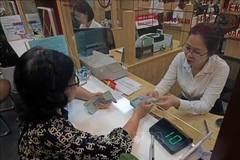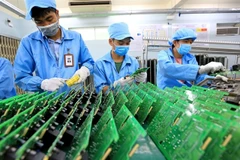At a conference about Industry 4.0 held on May 10 in Singapore, DoThi Thuy Huong from the Vietnam Electronic Industries Association (VEIA), saidthe COVID-19 pandemic and geopolitical conflicts were reshaping the globalsupply chain during the past three years.
From the beginning of this year, a number of heavyweights in theelectronics industry’s supply chain were looking to move to Vietnam, whichwould provide significant opportunities for Vietnamese enterprises toparticipate in the global supply chains and increase added value.
Huong also pointed out that there were opportunities to increaseexports to highly demanding markets and expand to new markets thanks to the adjustmentsin supply chains. Besides, the global production shift also broughtopportunities for Vietnam to attract high-quality foreign direct investment(FDI) in the electronics industry, especially in chip production.
New-generation free trade agreements (FTAs) were also creatingfavourable conditions for trade and investment.
Challenges were ahead, however, requiring Vietnam to adjustpolicies for enterprises and attract FDI to direct the capital flow into hightechnology sectors and sectors which would create a spillover effect for theVietnamese economy.
The fourth industrial revolution was also forcing Vietnam toswitch to innovation–driven growth, she said, stressing that cheap labour oravailable resources were no longer advantages.
Huong also pointed out that Vietnam lacked a skilled labour forcefor the electronics industry, which hindered the domestic industry in keepingpace with the development of the global electronics industry.
The technology transfer remained limited because of the capacityof enterprises in terms of human resources and infrastructure, she said.
Vietnamese electronics enterprises must improve their capacity tobe able to grab the opportunities, Huong stressed.
Darren Seah from the Industrial Transformation Asia – Pacific (ITAP)said that Vietnamese electronics enterprises had significant opportunities toparticipate in the global supply chain as there was a tendency to look for newproduction sites away from traditional markets.
Vietnam attracted large electronics groups such as Samsung, LG,Intel and Canon and the country could become an electronics production hub ofthe region, he said.
As the global consumption demand was forecast to drop this year,resulting in falling demand for high-tech items, which would affect the electronicsindustry.
Experts said that major challenges were the risk of supply chaindisruptions and the shortage of human resources.
In that context, enterprises should pay attention to the rapiddevelopment trends of digital economy, green finance and green transition,Hương said.
Electronics was the sector with the highest export revenue in themanufacturing industry during the past 10 years.
VEIA’s statistics showed that the electronics industry earnedexport revenue of more than 114 billion USD in 2022, accounting for more than30% of the country’s total export revenue. Last year, Vietnam ran a tradesurplus of 11.2 billion USD./.





























